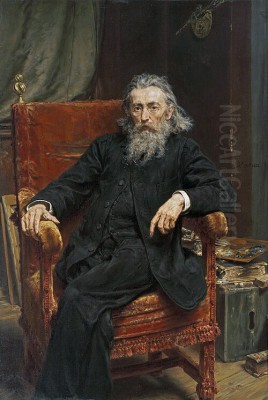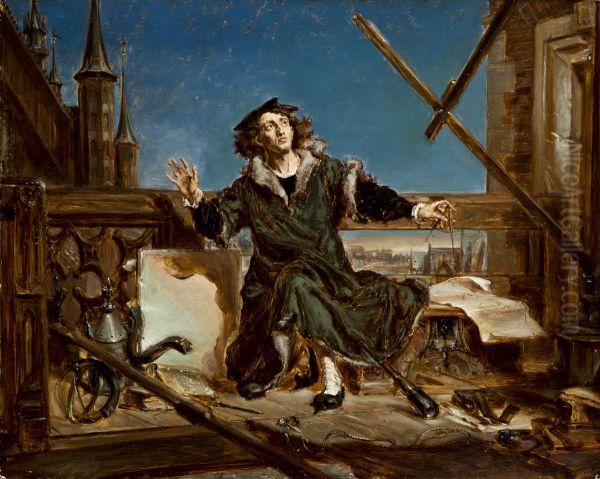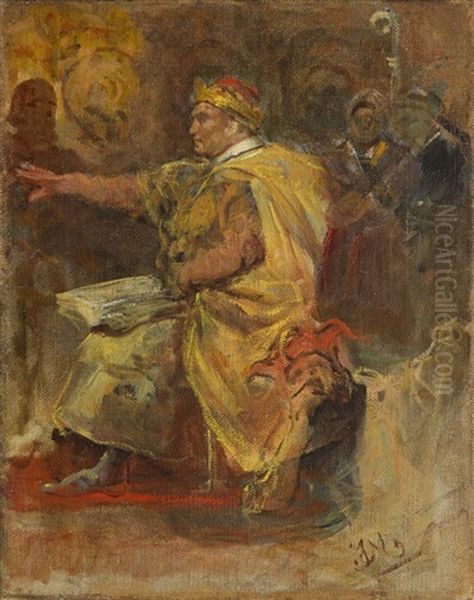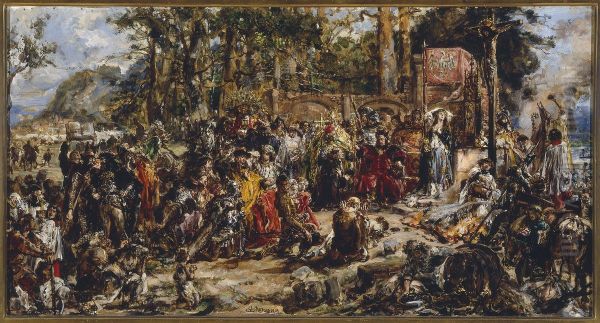
Jan Matejko stands as a towering figure in Polish art history, arguably the most significant historical painter the nation has ever produced. Living and working primarily during the latter half of the 19th century (1838-1893), a period when Poland did not exist as an independent political entity, Matejko dedicated his immense talent to chronicling the nation's tumultuous past. His monumental canvases, brimming with detail, drama, and patriotic fervor, served not only as artistic achievements but also as powerful tools for preserving national memory and fostering hope for a future restoration of sovereignty. Born in the Free City of Kraków, he became intrinsically linked with the city and its cultural life, eventually earning the unofficial title of Poland's "national painter." His work, deeply rooted in Romanticism and Historicism, continues to define the popular visual understanding of Polish history for many.
Early Life and Artistic Formation
Jan Matejko was born on June 24, 1838, in Kraków. His father, Franciszek Ksawery Matejko, was a Czech immigrant from Roudnice who worked as a music teacher. His mother, Joanna Karolina Rossberg, came from a Polonized German noble family. Jan was the ninth of eleven children. From a young age, he displayed exceptional artistic talent, though he struggled with other academic subjects. Recognizing his potential, his family enrolled him in the Kraków School of Fine Arts in 1852, when he was just fourteen.
At the Kraków School, he studied under influential teachers such as Wojciech Kornel Stattler and Władysław Łuszczkiewicz. Stattler, a proponent of Neoclassicism with Romantic leanings, and Łuszczkiewicz, a painter and art historian deeply interested in historical monuments, provided Matejko with a solid foundation in drawing, composition, and an appreciation for historical accuracy. Another figure who influenced his intellectual development during this period was Józef Kremer, a philosopher and art historian whose lectures Matejko attended.

Seeking broader horizons, Matejko continued his studies in Munich at the Academy of Fine Arts in 1859, primarily under the history painter Hermann Anschütz. While Munich was a major art center, Matejko did not feel entirely at home there. He found the prevailing academic style somewhat rigid. However, the exposure to the German historical painting tradition, particularly the work associated with figures like Karl von Piloty (though Piloty arrived later, his influence was pervasive in Munich), likely reinforced Matejko's own inclination towards large-scale historical narratives.
His educational journey also took him briefly to Vienna's Academy of Fine Arts in 1860. This stay proved short and contentious. A famous anecdote recounts a clash with Christian Ruben, the Academy's director. Ruben criticized Matejko's depiction in a historical sketch, allegedly finding fault with its portrayal of historical figures or its nationalistic undertones. Matejko, fiercely patriotic and sensitive to criticism regarding his interpretation of Polish history, reportedly argued vehemently with Ruben and soon left Vienna, returning to his beloved Kraków. This incident underscored his unwavering commitment to his artistic vision and his national themes.
The Emergence of a National Painter
Returning to Kraków, Matejko began to forge his unique artistic path. His early works started gaining recognition. A pivotal moment came with the painting Stańczyk (full title: Stańczyk during a Ball at the Court of Queen Bona upon the News of the Loss of Smolensk), completed in 1862. This relatively small but intensely powerful work depicts the court jester of Sigismund I the Old, slumped in a chair in melancholic contemplation while a ball continues in the background. The jester, traditionally a figure of mirth, is shown grieving over the news of a national setback (the loss of Smolensk to Muscovy in 1514). The painting is rich in symbolism, contrasting the frivolity of the court with the gravity of the political situation, and positioning the jester as the nation's conscience. It established Matejko as an artist capable of profound psychological depth and historical commentary.
Another major success followed with Skarga's Sermon (Kazanie Skargi), painted in 1864. This large canvas depicts Piotr Skarga, a famous Jesuit preacher of the late 16th and early 17th centuries, delivering a fiery sermon before King Sigismund III Vasa and the Polish elite, warning them of the dangers of internal division and moral decay that threatened the Polish-Lithuanian Commonwealth. The painting was exhibited at the Paris Salon of 1865, where it won a gold medal, bringing Matejko international attention. The work showcased his ability to handle complex multi-figure compositions, create dramatic tension, and imbue historical scenes with contemporary relevance, particularly for Poles living under foreign rule.

These early triumphs cemented Matejko's reputation and direction. He became increasingly focused on depicting crucial moments from Polish history, both glorious and tragic. Living through the failed January Uprising of 1863 against Russian rule undoubtedly deepened his sense of national duty and the urgency of preserving Poland's past through art. His paintings became more than just illustrations; they were visual sermons, lessons in history, and calls for national unity and resilience.
Masterpieces of Polish History
Matejko's mature period saw the creation of a series of monumental canvases that have become icons of Polish culture. Each work involved meticulous research into historical details, costumes, and settings, often utilizing Matejko's own extensive collection of historical artifacts.
Rejtan, or the Fall of Poland (1866): This highly dramatic and controversial painting depicts the Sejm (parliament) of 1773, during the First Partition of Poland. Tadeusz Rejtan, a deputy, is shown desperately trying to prevent his colleagues from passing the act of partition, tearing his shirt and barring the doorway in protest. The scene is filled with symbolic details, including Russian soldiers and the contemptuous figure of the Russian ambassador, Prince Repnin. While praised for its technical skill and emotional power, the work was criticized by some contemporaries for its harsh portrayal of the Polish nobility, seen as complicit or ineffective in the face of national disaster. It remains a powerful image of patriotic despair and resistance against overwhelming odds.
Union of Lublin (1869): Celebrating a moment of national triumph, this painting commemorates the 1569 treaty that formally united the Kingdom of Poland and the Grand Duchy of Lithuania into the Polish-Lithuanian Commonwealth. Matejko masterfully orchestrates a large assembly of historical figures, capturing the solemnity and political significance of the event. King Sigismund II Augustus is the central figure, presiding over the oath-taking ceremony. The work emphasizes the unity and shared destiny of the two nations, a poignant theme during the era of partitions.
Stefan Batory at Pskov (1872): This painting depicts a scene from the Livonian War (1558–1583), showing the powerful Polish King Stefan Batory receiving Russian envoys seeking peace after the grueling siege of Pskov. Batory, portrayed with regal authority and determination, represents the strength and military prowess of the Commonwealth during its peak. The work glorifies a moment of Polish military and diplomatic success against Muscovy, offering a contrast to the later periods of decline.

Astronomer Copernicus, or Conversations with God (1873): Shifting from political and military history, Matejko turned to the history of Polish science and culture. This evocative painting shows Nicolaus Copernicus, the revolutionary astronomer, observing the heavens from a tower in Frombork. Bathed in ethereal light, Copernicus appears deep in thought, seemingly communicating with the divine as he formulates his heliocentric theory. The painting celebrates Polish intellectual achievement and national pride, presenting Copernicus as a figure of global significance rooted in Polish soil.
The Battle of Grunwald (1878): Perhaps Matejko's most famous and ambitious work, this enormous canvas (over 4 by 9 meters) depicts the pivotal 1410 battle where the combined forces of Poland and Lithuania decisively defeated the Teutonic Knights. The painting is a whirlwind of action, a chaotic yet masterfully composed panorama of medieval warfare. Key figures like the Lithuanian Grand Duke Vytautas the Great and the legendary Polish knight Zawisza Czarny are identifiable amidst the melee. Completed over several years, the painting was hailed as a national epic, a powerful reminder of past glory and unity that resonated deeply with Poles under partition. Its sheer scale and dramatic intensity are overwhelming.
Prussian Homage (1882): This painting depicts the moment in 1525 when Albrecht Hohenzollern, the Grand Master of the Teutonic Knights, paid homage to the Polish King Sigismund I the Old in Kraków's Main Market Square, marking the secularization of Prussia as a Polish fiefdom. The scene is rendered with great pomp and detail, showcasing the power and prestige of the Jagiellonian dynasty at its zenith. Interestingly, Matejko includes the figure of Stańczyk, the court jester, looking on with a worried expression, perhaps foreshadowing future conflicts with Prussia.
Constitution of May 3, 1791 (1891): Painted towards the end of his life, this work commemorates the adoption of Europe's first modern codified national constitution. It depicts a procession of deputies and citizens celebrating the event as they move towards St. John's Cathedral in Warsaw. King Stanisław August Poniatowski is carried aloft, symbolizing a moment of national reform and hope just before the final partitions destroyed the Polish state. The painting captures the patriotic fervor and aspirations for a modernized, independent Poland.
Kościuszko at Racławice (1888): Another celebration of national heroism, this painting depicts Tadeusz Kościuszko, leader of the 1794 uprising against Russia and Prussia, after the victorious Battle of Racławice. Kościuszko is shown reviewing captured Russian cannons alongside peasant volunteers armed with scythes, who played a crucial role in the battle. The work highlights popular patriotism and the participation of common people in the struggle for independence.

Beyond these individual masterpieces, Matejko also undertook vast projects like the cycle History of Civilization in Poland, demonstrating his lifelong commitment to visually narrating the entirety of the nation's past.
Artistic Style and Technique
Jan Matejko's style is a unique synthesis of academic training, Romantic sensibility, and intense historical realism. He was a master draftsman and composer, capable of organizing vast numbers of figures and complex narratives within a single frame. His commitment to historical accuracy was legendary; he meticulously researched costumes, weaponry, architecture, and heraldry, often basing his depictions on historical artifacts, some from his own extensive collection.
Despite this realism in detail, his overall approach was highly dramatic and emotionally charged, characteristic of Romanticism. He employed theatrical lighting, dynamic poses, and expressive gestures to heighten the emotional impact of his scenes. His compositions are often dense and packed with detail, sometimes criticized as cluttered, but this density contributes to the sense of historical weight and complexity. He aimed not just to depict an event, but to interpret its significance and convey its emotional core.
His use of color was often rich and symbolic, though sometimes leaning towards darker, more somber palettes, especially in works dealing with tragic events. He was less interested in the atmospheric effects of light and color that preoccupied the Impressionists, who were his contemporaries in Western Europe. Matejko remained largely focused on narrative clarity and historical didacticism, using color and light primarily to model form and enhance drama rather than explore optical effects. His technique involved careful layering of oil paint to achieve depth and detail.
Themes of National Consciousness
The overarching theme in Matejko's work is Poland itself: its history, its identity, its triumphs, and its tragedies. During a time when Poland was erased from the map of Europe, divided between Russia, Prussia (later Germany), and Austria, Matejko's art served a vital function. His paintings provided a visual anchor for national identity, reminding Poles of their shared past and cultural heritage.
He frequently depicted Poland's "Golden Age," particularly the Jagiellonian and early Vasa periods, showcasing moments of political power, military victory, and cultural flourishing (e.g., Union of Lublin, Prussian Homage, Stefan Batory at Pskov). These works served to bolster national pride and counter the narratives of inherent Polish weakness often promoted by the partitioning powers.

Conversely, he did not shy away from depicting moments of crisis, internal strife, and national failure (e.g., Skarga's Sermon, Rejtan). These paintings often carried a moral message, warning against the political divisions and social weaknesses that had contributed to the Commonwealth's downfall. They served as cautionary tales, urging contemporary Poles towards unity and responsible citizenship.
Figures of national heroism are prominent, from kings and military leaders (Batory, Kościuszko) to cultural icons (Copernicus) and even symbolic figures representing the national conscience (Stańczyk, Skarga). Through these figures, Matejko celebrated Polish resilience, intellect, and patriotism. His work implicitly supported the struggle for independence, keeping the flame of national aspiration alive through powerful historical imagery. He essentially created a visual canon of Polish history that educated generations and shaped collective memory.
The Educator and His Sphere of Influence
Jan Matejko's impact extended beyond his own canvases. In 1873, he accepted the directorship of the Kraków School of Fine Arts (later Academy of Fine Arts), a position he held until his death in 1893. As director, he reformed the curriculum, emphasizing rigorous drawing skills and historical painting, while also fostering a patriotic atmosphere within the institution. He was a demanding but respected teacher, and his influence shaped a generation of Polish artists.
Many of his students went on to become leading figures in Polish art, often associated with the Young Poland (Młoda Polska) movement, which sought to create a modern national art style. Among his most notable pupils were:
Jacek Malczewski: A leading Symbolist painter, known for his allegorical works exploring themes of Polish history, art, and mortality, often with a highly personal and imaginative twist.
Stanisław Wyspiański: A true polymath – painter, playwright, poet, and designer – who became a central figure of the Young Poland movement, known for his expressive portraits, stained glass designs, and dramas infused with national symbolism.
Józef Mehoffer: Another prominent Young Poland artist, celebrated for his paintings, stained glass (especially the Fribourg Cathedral windows), and graphic art, blending Art Nouveau aesthetics with Polish themes.
Maurycy Gottlieb: A highly talented Jewish painter whose promising career was cut short by his early death. He explored both historical Polish and Jewish themes, demonstrating Matejko's influence but developing his own sensitive style.
Leon Wyczółkowski: A versatile artist associated with both Realism and Polish Impressionism, known for his landscapes, portraits, and still lifes, demonstrating that Matejko's students also explored directions beyond historical painting.
The "Matejko School" thus became a powerhouse of Polish art, even as many of his students moved beyond his specific style towards Symbolism, Impressionism, or Art Nouveau. His emphasis on technical skill, national themes, and the high calling of art left an indelible mark.
Contemporaries and International Context
While Matejko is primarily understood within the Polish context, it's important to place him among his European contemporaries. He achieved significant international recognition, winning medals at major exhibitions in Paris and Vienna. His historical paintings were part of a broader 19th-century European trend, where nations sought to define their identities through grand historical narratives in art.
In the German-speaking world, artists like Karl von Piloty in Munich represented a similar academic approach to historical painting, focusing on dramatic scenes and detailed realism. Matejko's brief time in Munich exposed him to this milieu. In Vienna, Hans Makart was a dominant figure, known for his opulent, decorative historical and allegorical paintings, stylistically quite different from Matejko's more earnest and didactic approach. The Hungarian painter Mihály Munkácsy also gained international fame for his dramatic historical and genre scenes, often compared to Matejko for their emotional intensity and realism, though Munkácsy spent much of his career in Paris and focused on different subject matter.
Within Poland itself, Matejko was the undisputed giant of historical painting, but other notable artists were active. Henryk Siemiradzki, based primarily in Rome, achieved international fame with large, highly polished academic paintings often depicting scenes from Greco-Roman antiquity, offering a different vision from Matejko's focus on Polish history. Artur Grottger, though dying young, created powerful cycles of drawings depicting the pathos and heroism of the January Uprising. The "Polish Munich School," including artists like Józef Brandt and Maksymilian Gierymski, specialized in realistic depictions of Polish history, often focusing on 17th-century wars and genre scenes, influenced by their studies in Munich. Aleksander Gierymski (Maksymilian's brother) explored Realism and proto-Impressionist light effects in his Warsaw scenes. Earlier figures like Piotr Michałowski excelled in Romantic depictions of Napoleonic battles and expressive horse studies.
Matejko interacted with some of these figures, particularly within the Kraków artistic community, but his singular focus and towering reputation set him somewhat apart. He remained largely insulated from the avant-garde movements like Impressionism that were transforming art in France, dedicating himself wholly to his national mission.
Controversies and Personal Life
Matejko's strong convictions and dramatic interpretations inevitably led to controversy. As mentioned, his painting Rejtan provoked criticism for its perceived negative portrayal of the Polish nobility, with some critics finding it almost anti-Polish despite its patriotic intent. His clash with Christian Ruben in Vienna highlighted his sensitivity regarding the portrayal of Polish history. Debates sometimes arose about the historical accuracy of his details or his conflation of figures from different time periods for dramatic effect; Matejko prioritized the overall message and emotional truth over strict historical pedantry.
His personal life was also marked by difficulties. In 1864, he married Teodora Giebułtowska. Their marriage produced several children but was reportedly tumultuous. Teodora suffered from mental health issues (possibly exacerbated by diabetes) and their relationship was often strained. Some biographers suggest that these personal struggles contributed to the sometimes somber or intense mood of his later works. Matejko himself was known for his intense work ethic, dedication, and sometimes difficult personality, fully absorbed in his artistic mission.
Despite occasional criticism or controversy, Matejko enjoyed immense respect and authority within Polish society. His position as Director of the Academy and his role as the nation's visual historian gave him significant cultural influence. He was seen by many as a national prophet, using his art to guide and inspire the nation during a dark period.
Legacy and Enduring Significance
Jan Matejko died on November 1, 1893, in Kraków. His funeral was a major public event, attended by vast crowds, testifying to his status as a national hero. He was buried in the main Rakowicki Cemetery in Kraków, in a place of honor. His former home and studio on Floriańska Street in Kraków were turned into a biographical museum, the Matejko House, now a branch of the National Museum in Kraków, preserving his personal effects, collection of historical artifacts, and some of his works.
Matejko's legacy is immense and multifaceted. Artistically, he represents the pinnacle of Polish historical painting in the 19th century. His technical skill, compositional mastery, and dramatic power remain impressive. Culturally, his paintings played an incalculable role in shaping Polish national consciousness during the partitions. His images became the definitive popular representations of key historical events and figures, deeply ingrained in the collective memory. For generations of Poles, Matejko's vision was Polish history.
His influence extended through his many students who went on to define Polish art in the early 20th century. While subsequent generations explored new artistic styles and sometimes reacted against his overwhelming influence, his status as a foundational figure remains secure. Today, his major works are treasured national icons, housed primarily in the National Museums in Warsaw and Kraków, drawing crowds and continuing to provoke discussion about history, art, and national identity. Jan Matejko did more than just paint history; he used history to paint a future for a nation yearning to be reborn.